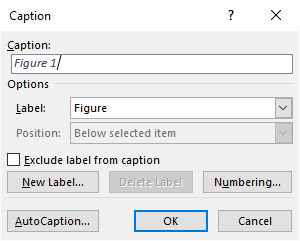Please Note: This article is written for users of the following Microsoft Word versions: 2007, 2010, 2013, 2016, 2019, 2021, and Word in Microsoft 365. If you are using an earlier version (Word 2003 or earlier), this tip may not work for you. For a version of this tip written specifically for earlier versions of Word, click here: Adding Captions.
Written by Allen Wyatt (last updated October 21, 2023)
This tip applies to Word 2007, 2010, 2013, 2016, 2019, 2021, and Word in Microsoft 365
Captions are normally included as a design element of a document. For instance, your design may dictate that every table needs to include a caption that identifies the table. There are two ways you can add a caption in your document. The first is to create your own, and the second is to have Word add the caption for you.
If you want to add your own caption, simply start a new paragraph and type the caption. Then make sure that the paragraph is formatted with the Caption style.
If you want to instruct Word to add the caption, follow these steps:

Figure 1. The Caption dialog box.
Since there are multiple steps to insert a caption in this fashion, you may wonder why anyone would use Word to add the caption. There are a couple of reasons. First of all, when Word inserts the caption there is a certain amount of uniformity that is used. You can specify the same label to appear at the beginning of each of your captions. Second, the number that is added to the caption is created as a sequence field. This means that even if you later move the caption, the numbering of the caption will be automatically updated and corrected by Word. Finally, if you aren't comfortable working with styles, using Word to add the caption precludes you from the necessity of assigning styles.
WordTips is your source for cost-effective Microsoft Word training. (Microsoft Word is the most popular word processing software in the world.) This tip (6267) applies to Microsoft Word 2007, 2010, 2013, 2016, 2019, 2021, and Word in Microsoft 365. You can find a version of this tip for the older menu interface of Word here: Adding Captions.

Discover the Power of Microsoft Office This beginner-friendly guide reveals the expert tips and strategies you need to skyrocket your productivity and use Office 365 like a pro. Mastering software like Word, Excel, and PowerPoint is essential to be more efficient and advance your career. Simple lessons guide you through every step, providing the knowledge you need to get started. Check out Microsoft Office 365 For Beginners today!
Caption labels can be useful when you are adding document elements such as tables and figures. Word allows you to create ...
Discover MoreDefine a custom label to be used for captions, and you may later want to delete that label. Here's how you can easily ...
Discover MoreUsing Word's captioning feature can be a great boon for automatically numbering certain elements in your documents. It ...
Discover MoreFREE SERVICE: Get tips like this every week in WordTips, a free productivity newsletter. Enter your address and click "Subscribe."
2023-10-22 20:01:54
Peter Riches
Hi Allen, I would add that the other advantage of using the 'insert caption' function of Word is then you can then use cross-reference to refer to the item (e.g. see Table 4, see Figure 7) and these numbers will also update automatically.
Got a version of Word that uses the ribbon interface (Word 2007 or later)? This site is for you! If you use an earlier version of Word, visit our WordTips site focusing on the menu interface.
Visit the WordTips channel on YouTube
FREE SERVICE: Get tips like this every week in WordTips, a free productivity newsletter. Enter your address and click "Subscribe."
Copyright © 2025 Sharon Parq Associates, Inc.
Comments